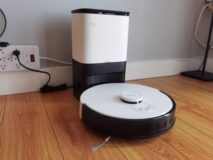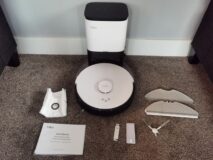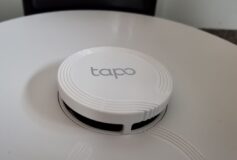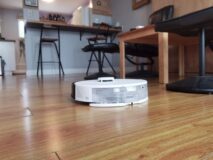
Robot vacuums are becoming a regular fixture in smart homes. The technology has improved to the point that they actually work. The newest versions have obstacle avoidance technology and smart mapping tools. Some are mop and vacuum combinations with self-emptying base stations. With so many choices, how can you decide which one is right for you?
That’s where reviews like this come into play. I’m reviewing the Tapo RV30 Plus. This is a vacuum and mop combo with LiDAR & Gyro dual navigation system. Best of all, it claims to run for up to 70 days before the dust bag needs to be emptied. Does it have what it takes to complete with more established brands? Let’s find out.
Unboxing the Tapo RV30 Plus
Inside the box, you will find nine different pieces. This includes the robot vacuum cleaner, the auto-empty dock, mop cloth mount, and the quick installation guide. You will also find two washable mop cloths, 4L disposable dust bag, side brushes, HEPA filter, and the cleaning brush.
Design of the Tapo RV30 Plus
The Tapo RV30 Plus is white with black trim on the front. It has a modern, functional look. With a circular design, the front is rubber coated. This prevents damage to furniture or walls as it moves around your home. On the top are three buttons. This starts the vacuum, pauses cleaning, or returns it home. It also features a power switch on the side. This manually turns the vacuum off for parties, travel, etc. Under the hood is a 5,000 mAh battery for three hours of continuous cleaning. The motor is capable of producing 4,200 Pa of suction power.
To get the most out of a robot vacuum, regular maintenance is key. The components of the Tapo RV30 Plus can be detached for cleaning. This includes the main brush and the dustbin/watertank. The HEPA filter captures allergens and other debris while cleaning.
Dual navigation systems in the Tapo RV30 Plus
The Tapo RV30 Plus uses LiDAR & Gyro navigation systems, which provides several key functions. First, it maps out a house to plan its path. It can store multiple maps for larger homes. Second, the sensors detect objects to prevent collisions. It also detects stairs to prevent it from falling over. Lastly, the dual navigation system avoids repeated cleanings and allows the vacuum to operate in the dark.
Setting up the Tapo RV30 Plus
I tested the Tapo RV30 Plus in my Airbnb suite. A guest checked out after five days and the floor was noticeably dirty. This made for a perfect test case. It’s a laminate floor with a carpet mat at the entry and standing mats in the kitchen. The entry mat was very dirty so I focused my attention on that area during the test.
To set up the Tapo RV30 Plus, I downloaded the TP-Link Tapo app. After creating an account, I followed the in-app instructions. Next, I manually switched on the Tapo RV30 Plus and connected it to my home network. Once that was completed, it left the charging station and mapped out the room. I was very impressed with the robot’s ability to accurately map my space.
Using the Tapo RV30 Plus
Once charged, I did a manual clean. The Tapo RV30 Plus is very quiet, the noise didn’t bother me at all. I could watch the cleaning on the Tapo app. That’s a great feature when setting a clean remotely. You can see the cleaning happening in real-time on the app. In the app, you can set cleaning schedules at specific times during the week. You can also specify specific rooms to clean instead of the whole house. Further, you can set personalized cleaning settings for each room. For example, setting the Tapo RV30 Plus to full suction speed in the foyer of a house where people are entering. After the clean was completed, I inspected the room. While the floor looked clean, I could still see some pine needles in the carpet.
For the next clean, I increased the suction power in the Tapo app. On the second clean with max suction, the carpet at the entrance was noticeably cleaner. I opened the dust bin and it was full of debris. The Tapo RV30 Plus did a great cleaning job. I was impressed.
Mopping
I’ve tried many robot vacuum/mop models and I’ve never been a fan of the mopping results. The Tapo RV30 Plus features a removable mop pad that attaches on the back of the robot. The water tank inside the dustbin is 300mL capacity. With a full tank, it can mop an up to 2,100 square feet space. Depending on your floor type, you can select from three levels of water flow.
I let the Tapo RV30 Plus mop the entire room. Once again, I’m not impressed. Even a bad, quick manual mop would produce better results. Plus, you have to manually remove the mop pad and wash it. Nevertheless, there are three water levels from which to select. Personally, I would avoid the mop function and strictly use it as a robot vacuum.
Who is the Tapo RV30 Plus for?
If you’re in the market for a robot vacuum, you need to first inspect your place. Is there anything that would obstruct it from entering a room? This could be transition strips between laminate flooring in hallways to carpeted rooms. The Tapo RV30 is great for large homes with multiple rooms on a single level. However, it needs to be clear of obstructions that it might get stuck on. In my case, it was a door stopper.
The Tapo RV30 can clean large spaces with customized settings for each room. Plus the 70-day dust bag ensures it can work for an extended period of time. But forget about the mopping features. The end result is just not worth it. Get yourself a good mop and bucket and do it the old fashioned way.
Final thoughts
Over time as robot vacuums have gotten more intelligent since being released into the market and they now come with better features for convenience. We’re at a point where they can actually replace manual vacuuming for regular, daily maintenance. If you’re looking for some help from a cleaning robot, check out the Tapo RV30 Plus robot vacuum available now at bestbuy.ca.







